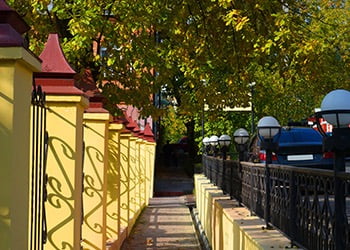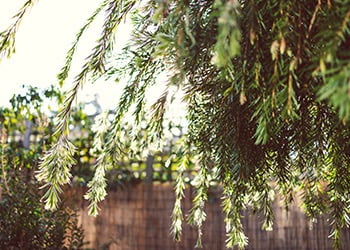Disagreements over trees are very common, however the way you handle a tree dispute could be the difference between getting an invite to the next Christmas party or ending up in court. Here we take a look at how to best handle a tree maintenance dispute and how you can try to avoid them happening in the first place.
What Is A Tree Dispute?

According to the Queensland Civil and Administrative Tribunal or QCAT, a tree dispute is a disagreement between neighbours about one or more trees on adjoining properties.
Tree disputes can arise when:
- Tree branches are overhanging a fence
- A tree is dropping fruit, seeds, leaf litter or flowers onto a property
- Tree roots are causing damage to a property
- Tree branches are blocking sunlight, a view or impeding television reception
What Should I Do if I Have A Tree Dispute?

1. Know the rules and your rights
Always know what your rights are, what your legal responsibilities are as a tree-keeper and what you can legally do if you’re having a dispute. This is the best way to avoid having problems with neighbours as you’ll be armed with the relevant knowledge if an issue does come up.
It’s important to know who the actual tree-keeper is so you know who to speak to. In the majority of cases, the tree-keeper will be the registered owner of the land the tree is growing on. If you’re unsure about who owns the land, you can find this information in the freehold land register under the Land Title Act 1994. The tree-keeper could be an individual, a body corporate or an organisation.
Legally speaking, a neighbour’s tree is regarded as negatively affecting you if it would be likely, in the next twelve months to:
- Cause serious injury to anyone on your land
- Cause serious damage to your land or any of your property
- Unreasonably impede your use and enjoyment of your land
If for example, you have a very common problem where a neighbour’s tree is overhanging your land, you can legally remove the overhanging branches to the boundary line of your property. This is the common law right of abatement.
You can choose whether to return the branches, roots, fruit or other matter to your neighbour or dispose of them yourself. You must however, be sure to comply with any existing vegetation protection orders before doing anything.
If your neighbour’s tree is causing problems, you can’t reach an agreement and you aren’t able to remove the branches yourself exercising the common law right of abatement – you can give them a written notice to remove the branches using a specific ‘form 3’ available on the Queensland Government’s publication portal which you can find here: https://www.publications.qld.gov.au/dataset/notices-to-neighbours.
Note however, that this avenue is only available if the branches are overhanging by more than 50 centimetres and are less than 2.5 metres above the ground. The tree must not be covered by any vegetation protection order. If the offending branches are overhanging by more than 50 centimetres and are over 2.5 metres above the ground you can apply to QCAT for an order.
Your rights regarding tree disputes are covered by:
- The Neighbourhood Disputes (Dividing Fences and Trees) Act 2011 – formerly known as Neighbourhood Disputes Resolution Act 2011, and
- The Queensland Civil and Administrative Tribunal Act 2009
Both acts are available on the Office of the Queensland Parliamentary Counsel website.
2. Open the lines of communication
If you are having an issue with a neighbour’s tree, the best thing to do in the first instance is to talk with the tree-keeper and try to reach a solution. If the issue can be resolved at this stage it will be a much faster, cheaper and less stressful situation. Your neighbour might not even be aware that there is a problem, and it may be quickly resolved at this stage.
Before meeting, think through what you would like to have happen in accordance with the rules and regulations. Face to face meetings are usually best where you can both discuss the issues. Be mindful of your tone and try not to place blame, tree disputes can quickly escalate and devolve into an argument which won’t achieve anything. Clearly explain how the issue is affecting you and give your neighbour a chance to speak.
3. Put your agreement in writing
If you and your neighbour are able to agree to a solution, it’s a great idea to put it in writing. That way you have a time-stamped record of what was agreed to, and you can then come back to it down the track to check progress is on track and prevent any confusion.
4. Get legal advice
If however you find yourself in a situation where you cannot agree on a solution, you may need to consider seeking legal advice about what your options are. You can get advice around how the law applies in your specific situation from your local community legal centre or through hiring your own lawyer. The Queensland Law Society can refer you to a lawyer that will be able to help.
5. Go to mediation
Mediation is another option if you can’t come to an agreement and want to stay out of court. Mediation is quicker, easier and much cheaper than taking legal action. Mediation basically involves you being taken through a structured mediation process by a fully trained mediator acting as a neutral third party to try to resolve your dispute. You can find Dispute Resolution Centres here in Brisbane to do this.
6. Resolve your dispute through QCAT
QCAT can make many different orders in accordance with the specific situation. They may request a survey to determine who actually owns the tree, they might order for an Arborist to carry out work or they might advise compensation is due for damages to a property for example. Failure to comply with a QCAT order can result in severe fines, up to $100,000 depending on the particular case.
If you’re unsure about what to do, ask your local Arborist for some professional tree maintenance advice and have them advise the best course of action.
How To Reduce Your Risk Of Having A Tree Dispute

As with most things, prevention is generally better than cure. Here are our tips for how you can reduce your chances of having a tree dispute with your neighbour.
- Know your responsibilities as a ‘tree keeper’
- Maintain your own trees so they don’t impact neighbour’s properties
- Get professional advice on tree selection, care and maintenance
- Be on good terms with your neighbours
Keep your neighbours and your trees happy and let the professionals take the hassle out of your tree care. Aussie Tree Solutions have been taming South-East Queensland trees for over 35 years, and we provide a range of services from tree removals and tree pruning to emergency storm damage. Call Aussie Tree Solutions anytime, 24/7 and ask for a free quote on our tree maintenance services.

